University College of Estate Management Condition Report Assignment
VerifiedAdded on 2022/11/13
|22
|3884
|277
Report
AI Summary
This report, prepared as part of the 'Surveying and Maintaining Buildings' module (BSU5SMB) at the University College of Estate Management, presents a condition assessment following a format similar to the RICS Condition Report. The assignment focuses on a level 1 inspection, emphasizing visual assessment with limitations, and requires the student to identify and analyze two specific defects, providing detailed explanations and justifications for their condition ratings, including citations from authoritative sources. The report covers various elements of the property, including the exterior (roof coverings, main walls, and doors) and interior (walls and floors), detailing their condition and any identified defects. Notably, the report highlights a significant crack in the main wall and explains the classification of the crack based on BRE guidelines. The student provides a breakdown of the condition ratings (1, 2, and 3), summarizing the condition of different building elements and justifying the chosen ratings. The report also includes the property's details and the services present, demonstrating an understanding of the building's overall condition and potential areas requiring further investigation.
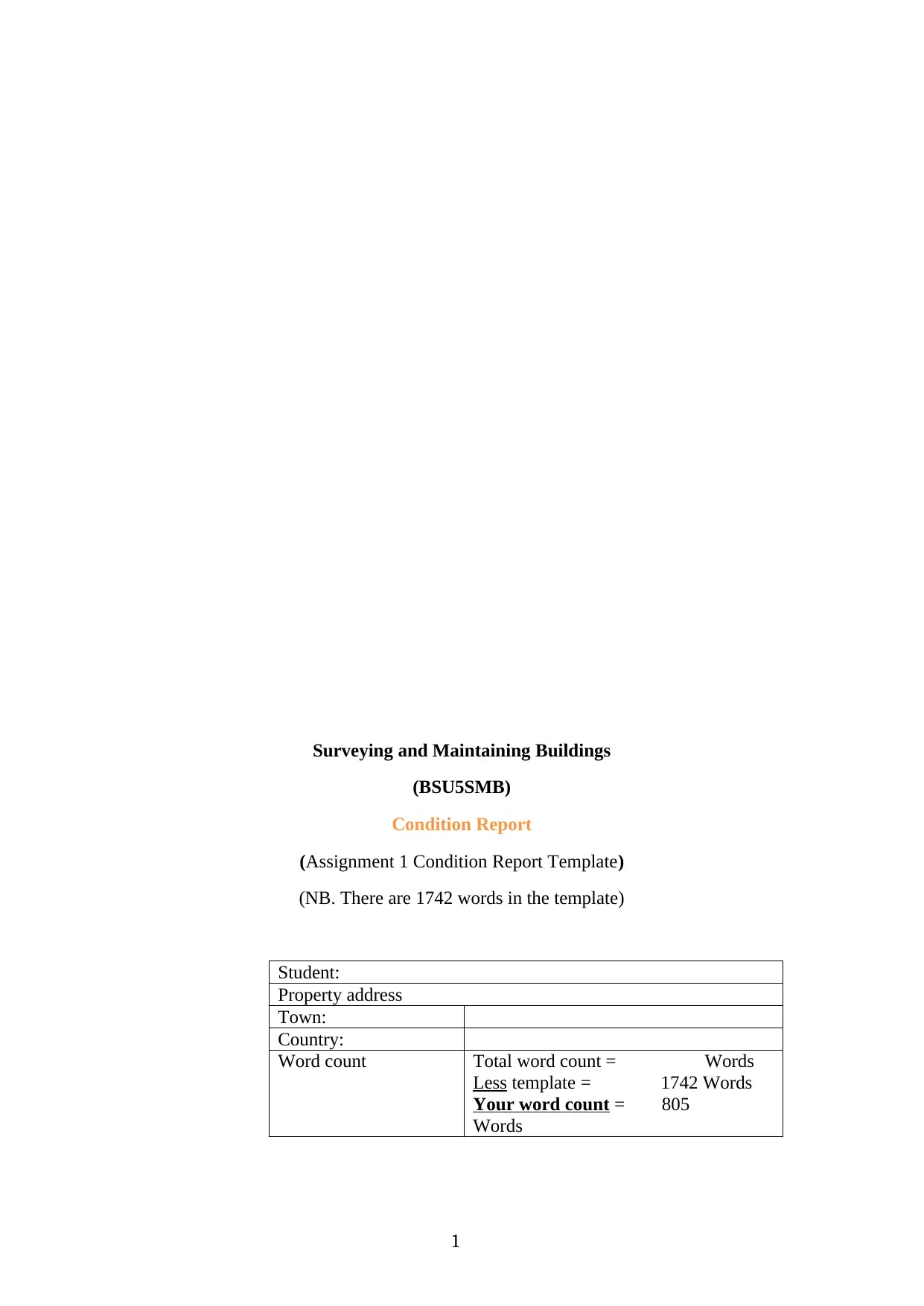
Surveying and Maintaining Buildings
(BSU5SMB)
Condition Report
(Assignment 1 Condition Report Template)
(NB. There are 1742 words in the template)
Student:
Property address
Town:
Country:
Word count Total word count = Words
Less template = 1742 Words
Your word count = 805
Words
1
(BSU5SMB)
Condition Report
(Assignment 1 Condition Report Template)
(NB. There are 1742 words in the template)
Student:
Property address
Town:
Country:
Word count Total word count = Words
Less template = 1742 Words
Your word count = 805
Words
1
Paraphrase This Document
Need a fresh take? Get an instant paraphrase of this document with our AI Paraphraser

2
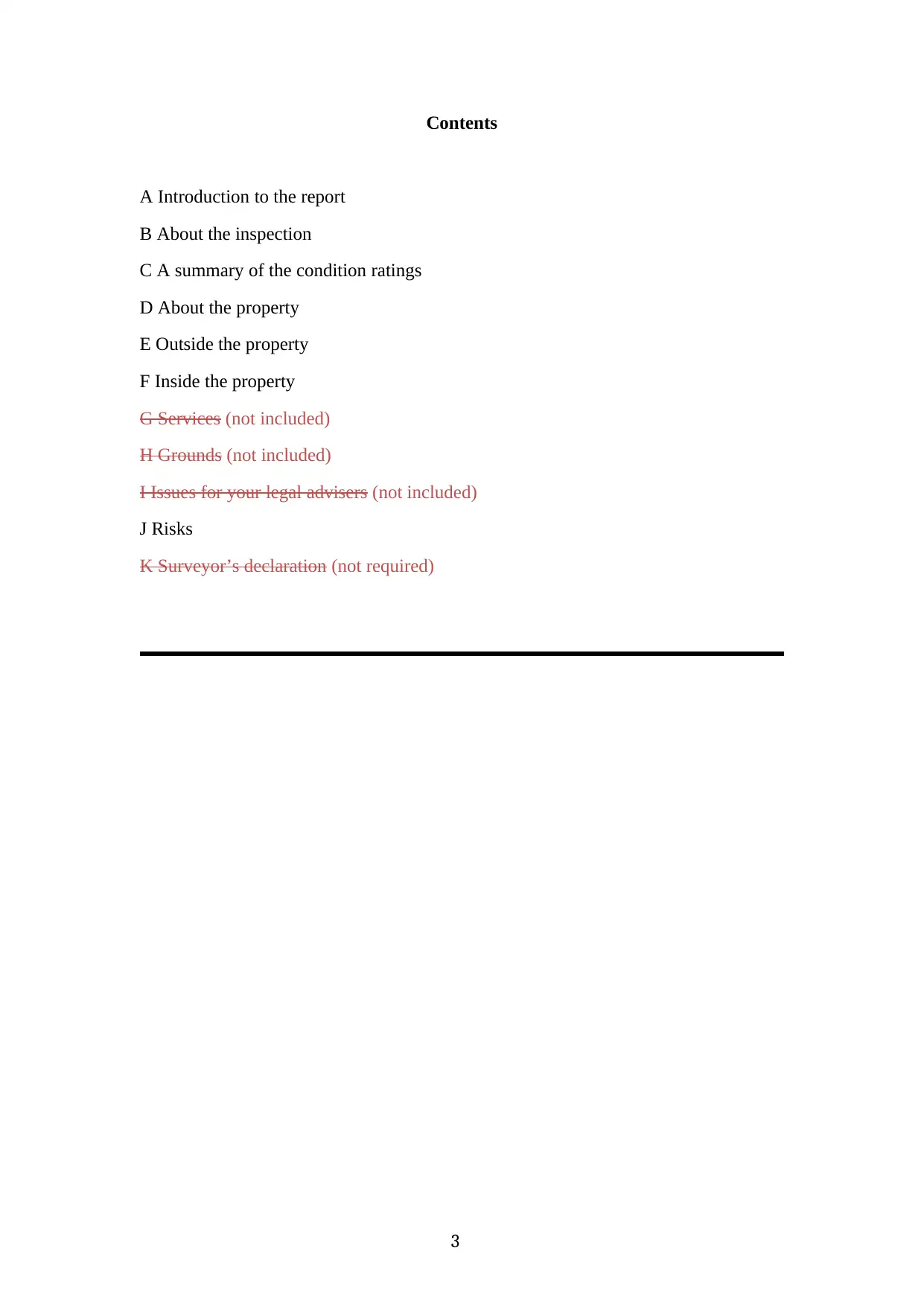
Contents
A Introduction to the report
B About the inspection
C A summary of the condition ratings
D About the property
E Outside the property
F Inside the property
G Services (not included)
H Grounds (not included)
I Issues for your legal advisers (not included)
J Risks
K Surveyor’s declaration (not required)
3
A Introduction to the report
B About the inspection
C A summary of the condition ratings
D About the property
E Outside the property
F Inside the property
G Services (not included)
H Grounds (not included)
I Issues for your legal advisers (not included)
J Risks
K Surveyor’s declaration (not required)
3
⊘ This is a preview!⊘
Do you want full access?
Subscribe today to unlock all pages.

Trusted by 1+ million students worldwide
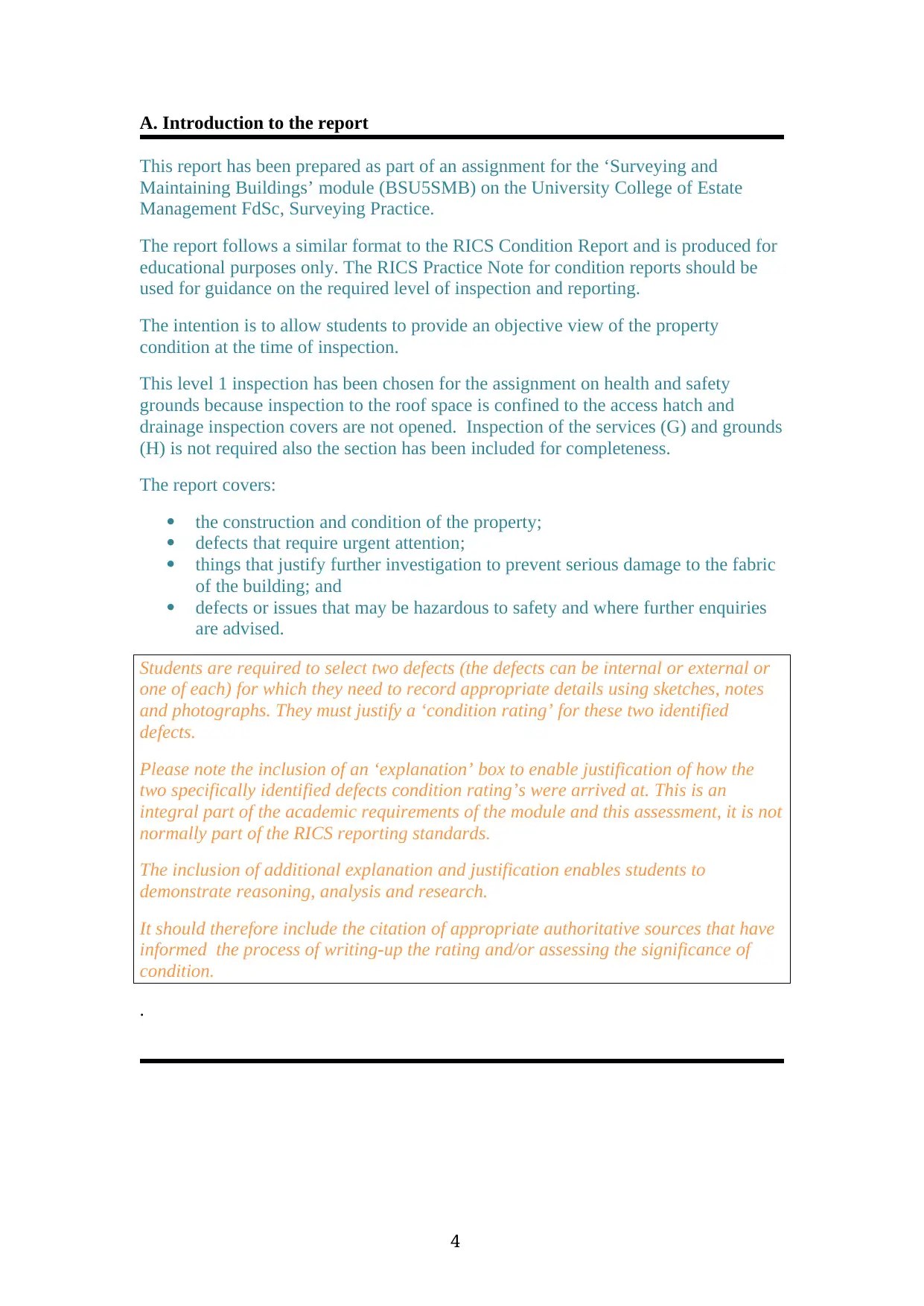
A. Introduction to the report
This report has been prepared as part of an assignment for the ‘Surveying and
Maintaining Buildings’ module (BSU5SMB) on the University College of Estate
Management FdSc, Surveying Practice.
The report follows a similar format to the RICS Condition Report and is produced for
educational purposes only. The RICS Practice Note for condition reports should be
used for guidance on the required level of inspection and reporting.
The intention is to allow students to provide an objective view of the property
condition at the time of inspection.
This level 1 inspection has been chosen for the assignment on health and safety
grounds because inspection to the roof space is confined to the access hatch and
drainage inspection covers are not opened. Inspection of the services (G) and grounds
(H) is not required also the section has been included for completeness.
The report covers:
the construction and condition of the property;
defects that require urgent attention;
things that justify further investigation to prevent serious damage to the fabric
of the building; and
defects or issues that may be hazardous to safety and where further enquiries
are advised.
Students are required to select two defects (the defects can be internal or external or
one of each) for which they need to record appropriate details using sketches, notes
and photographs. They must justify a ‘condition rating’ for these two identified
defects.
Please note the inclusion of an ‘explanation’ box to enable justification of how the
two specifically identified defects condition rating’s were arrived at. This is an
integral part of the academic requirements of the module and this assessment, it is not
normally part of the RICS reporting standards.
The inclusion of additional explanation and justification enables students to
demonstrate reasoning, analysis and research.
It should therefore include the citation of appropriate authoritative sources that have
informed the process of writing-up the rating and/or assessing the significance of
condition.
.
4
This report has been prepared as part of an assignment for the ‘Surveying and
Maintaining Buildings’ module (BSU5SMB) on the University College of Estate
Management FdSc, Surveying Practice.
The report follows a similar format to the RICS Condition Report and is produced for
educational purposes only. The RICS Practice Note for condition reports should be
used for guidance on the required level of inspection and reporting.
The intention is to allow students to provide an objective view of the property
condition at the time of inspection.
This level 1 inspection has been chosen for the assignment on health and safety
grounds because inspection to the roof space is confined to the access hatch and
drainage inspection covers are not opened. Inspection of the services (G) and grounds
(H) is not required also the section has been included for completeness.
The report covers:
the construction and condition of the property;
defects that require urgent attention;
things that justify further investigation to prevent serious damage to the fabric
of the building; and
defects or issues that may be hazardous to safety and where further enquiries
are advised.
Students are required to select two defects (the defects can be internal or external or
one of each) for which they need to record appropriate details using sketches, notes
and photographs. They must justify a ‘condition rating’ for these two identified
defects.
Please note the inclusion of an ‘explanation’ box to enable justification of how the
two specifically identified defects condition rating’s were arrived at. This is an
integral part of the academic requirements of the module and this assessment, it is not
normally part of the RICS reporting standards.
The inclusion of additional explanation and justification enables students to
demonstrate reasoning, analysis and research.
It should therefore include the citation of appropriate authoritative sources that have
informed the process of writing-up the rating and/or assessing the significance of
condition.
.
4
Paraphrase This Document
Need a fresh take? Get an instant paraphrase of this document with our AI Paraphraser
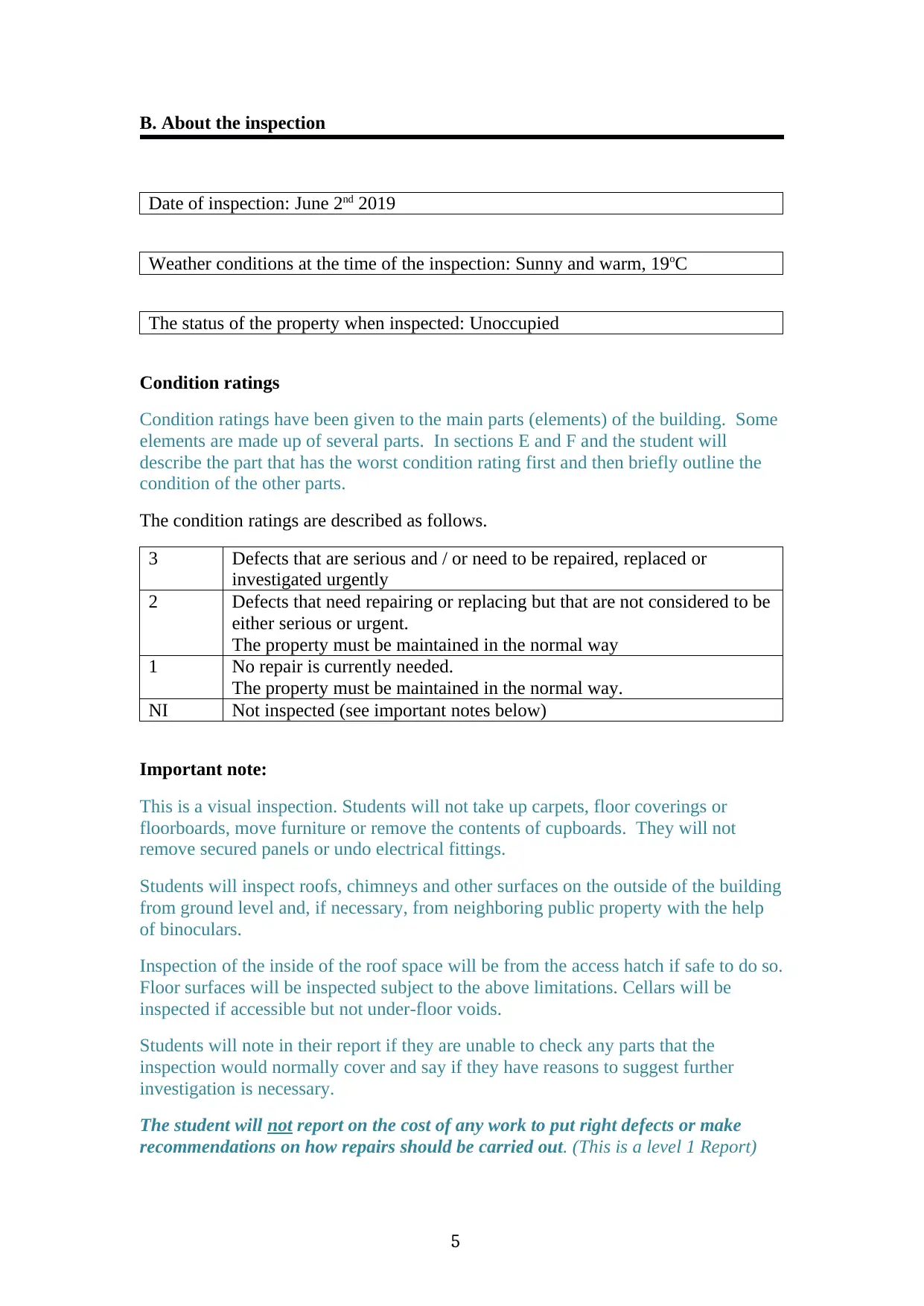
B. About the inspection
Date of inspection: June 2nd 2019
Weather conditions at the time of the inspection: Sunny and warm, 19oC
The status of the property when inspected: Unoccupied
Condition ratings
Condition ratings have been given to the main parts (elements) of the building. Some
elements are made up of several parts. In sections E and F and the student will
describe the part that has the worst condition rating first and then briefly outline the
condition of the other parts.
The condition ratings are described as follows.
3 Defects that are serious and / or need to be repaired, replaced or
investigated urgently
2 Defects that need repairing or replacing but that are not considered to be
either serious or urgent.
The property must be maintained in the normal way
1 No repair is currently needed.
The property must be maintained in the normal way.
NI Not inspected (see important notes below)
Important note:
This is a visual inspection. Students will not take up carpets, floor coverings or
floorboards, move furniture or remove the contents of cupboards. They will not
remove secured panels or undo electrical fittings.
Students will inspect roofs, chimneys and other surfaces on the outside of the building
from ground level and, if necessary, from neighboring public property with the help
of binoculars.
Inspection of the inside of the roof space will be from the access hatch if safe to do so.
Floor surfaces will be inspected subject to the above limitations. Cellars will be
inspected if accessible but not under-floor voids.
Students will note in their report if they are unable to check any parts that the
inspection would normally cover and say if they have reasons to suggest further
investigation is necessary.
The student will not report on the cost of any work to put right defects or make
recommendations on how repairs should be carried out. (This is a level 1 Report)
5
Date of inspection: June 2nd 2019
Weather conditions at the time of the inspection: Sunny and warm, 19oC
The status of the property when inspected: Unoccupied
Condition ratings
Condition ratings have been given to the main parts (elements) of the building. Some
elements are made up of several parts. In sections E and F and the student will
describe the part that has the worst condition rating first and then briefly outline the
condition of the other parts.
The condition ratings are described as follows.
3 Defects that are serious and / or need to be repaired, replaced or
investigated urgently
2 Defects that need repairing or replacing but that are not considered to be
either serious or urgent.
The property must be maintained in the normal way
1 No repair is currently needed.
The property must be maintained in the normal way.
NI Not inspected (see important notes below)
Important note:
This is a visual inspection. Students will not take up carpets, floor coverings or
floorboards, move furniture or remove the contents of cupboards. They will not
remove secured panels or undo electrical fittings.
Students will inspect roofs, chimneys and other surfaces on the outside of the building
from ground level and, if necessary, from neighboring public property with the help
of binoculars.
Inspection of the inside of the roof space will be from the access hatch if safe to do so.
Floor surfaces will be inspected subject to the above limitations. Cellars will be
inspected if accessible but not under-floor voids.
Students will note in their report if they are unable to check any parts that the
inspection would normally cover and say if they have reasons to suggest further
investigation is necessary.
The student will not report on the cost of any work to put right defects or make
recommendations on how repairs should be carried out. (This is a level 1 Report)
5

6
⊘ This is a preview!⊘
Do you want full access?
Subscribe today to unlock all pages.

Trusted by 1+ million students worldwide
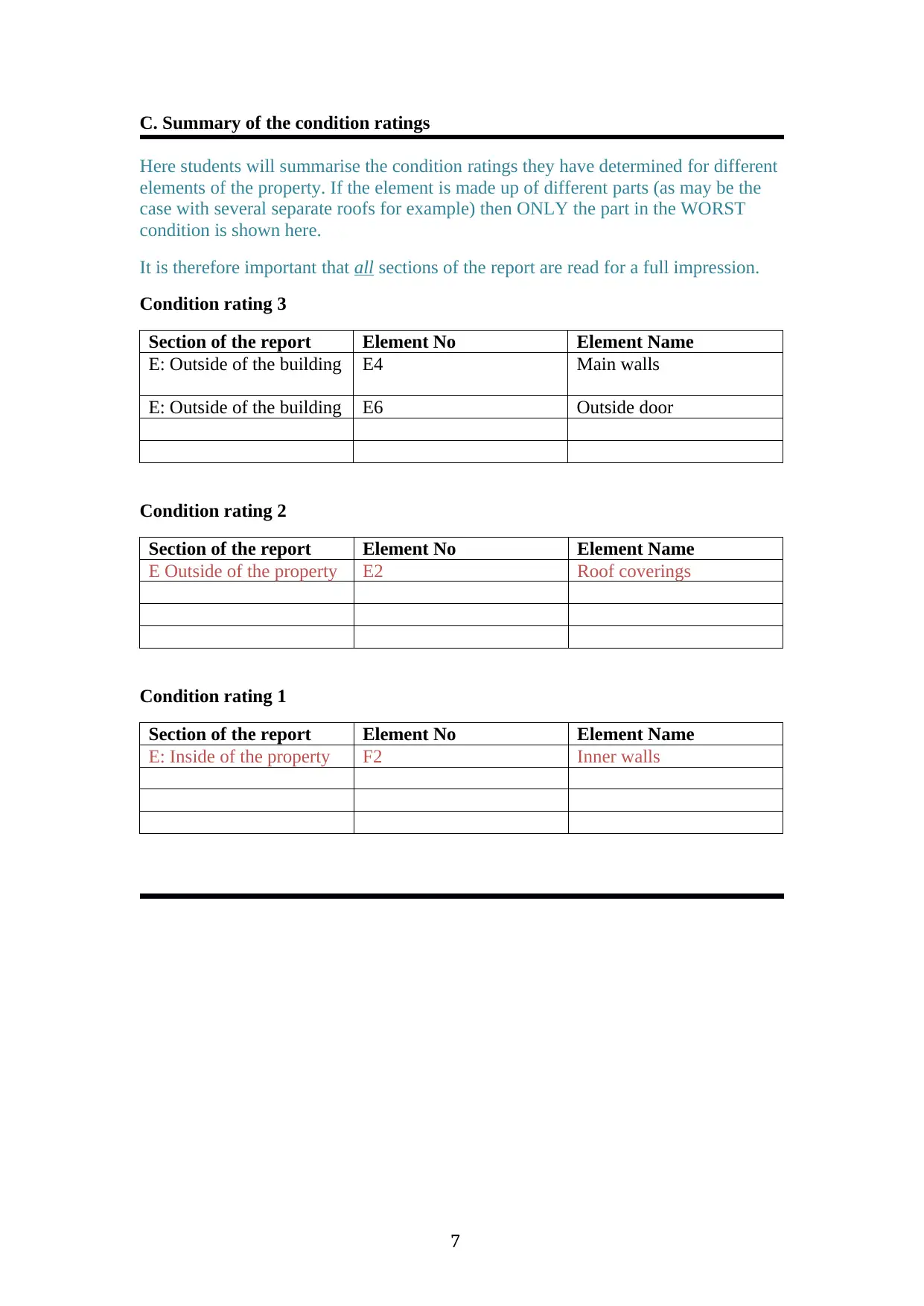
C. Summary of the condition ratings
Here students will summarise the condition ratings they have determined for different
elements of the property. If the element is made up of different parts (as may be the
case with several separate roofs for example) then ONLY the part in the WORST
condition is shown here.
It is therefore important that all sections of the report are read for a full impression.
Condition rating 3
Section of the report Element No Element Name
E: Outside of the building E4 Main walls
E: Outside of the building E6 Outside door
Condition rating 2
Section of the report Element No Element Name
E Outside of the property E2 Roof coverings
Condition rating 1
Section of the report Element No Element Name
E: Inside of the property F2 Inner walls
7
Here students will summarise the condition ratings they have determined for different
elements of the property. If the element is made up of different parts (as may be the
case with several separate roofs for example) then ONLY the part in the WORST
condition is shown here.
It is therefore important that all sections of the report are read for a full impression.
Condition rating 3
Section of the report Element No Element Name
E: Outside of the building E4 Main walls
E: Outside of the building E6 Outside door
Condition rating 2
Section of the report Element No Element Name
E Outside of the property E2 Roof coverings
Condition rating 1
Section of the report Element No Element Name
E: Inside of the property F2 Inner walls
7
Paraphrase This Document
Need a fresh take? Get an instant paraphrase of this document with our AI Paraphraser

D. About the property
Type of
property
Detached two storey house with a basement and a garage
Facing North
Approximate year
built
1978 based on first sale agreement
Approximate date of extension /
alteration
May 2005
Accommodation
Floor Living
rooms
Bedroo
ms
Bath or
shower
Separat
e toilet
Kitche
n
Utility
room
Conser
vatory
Other
Lower
Groun
d
2 2 1 1 1 1 Garage
First 2 2
Construction
Here the student will summarise the construction technique and materials used.
The house is made of brick that covers all the outer walls while the inner wall is
covered with a layer of plaster. The wall is double layered with insulating material
in between. The doors are made of wood, while the floor is made of concrete and
covered in wooden tiles. The windows are made of glass and the roof is made of
Grey felt shingles.
Energy
The student is not expected to have seen the Energy Performance Certificate
Mains services
The student has determined that the following services are present (indicate Y or N).
Gas Y Electrici
ty
Y Water Y Drainag
e
Y
8
Type of
property
Detached two storey house with a basement and a garage
Facing North
Approximate year
built
1978 based on first sale agreement
Approximate date of extension /
alteration
May 2005
Accommodation
Floor Living
rooms
Bedroo
ms
Bath or
shower
Separat
e toilet
Kitche
n
Utility
room
Conser
vatory
Other
Lower
Groun
d
2 2 1 1 1 1 Garage
First 2 2
Construction
Here the student will summarise the construction technique and materials used.
The house is made of brick that covers all the outer walls while the inner wall is
covered with a layer of plaster. The wall is double layered with insulating material
in between. The doors are made of wood, while the floor is made of concrete and
covered in wooden tiles. The windows are made of glass and the roof is made of
Grey felt shingles.
Energy
The student is not expected to have seen the Energy Performance Certificate
Mains services
The student has determined that the following services are present (indicate Y or N).
Gas Y Electrici
ty
Y Water Y Drainag
e
Y
8
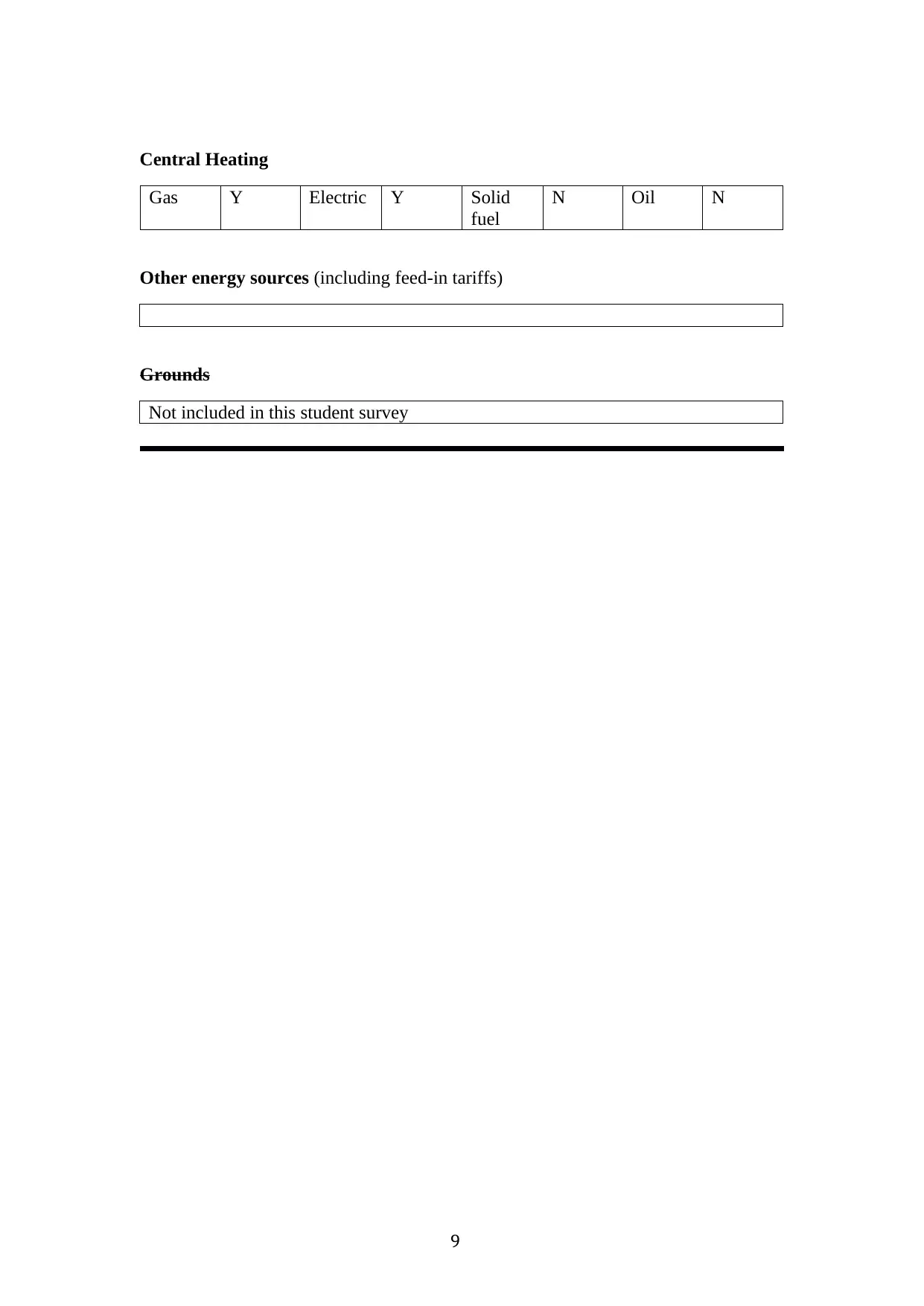
Central Heating
Gas Y Electric Y Solid
fuel
N Oil N
Other energy sources (including feed-in tariffs)
Grounds
Not included in this student survey
9
Gas Y Electric Y Solid
fuel
N Oil N
Other energy sources (including feed-in tariffs)
Grounds
Not included in this student survey
9
⊘ This is a preview!⊘
Do you want full access?
Subscribe today to unlock all pages.

Trusted by 1+ million students worldwide
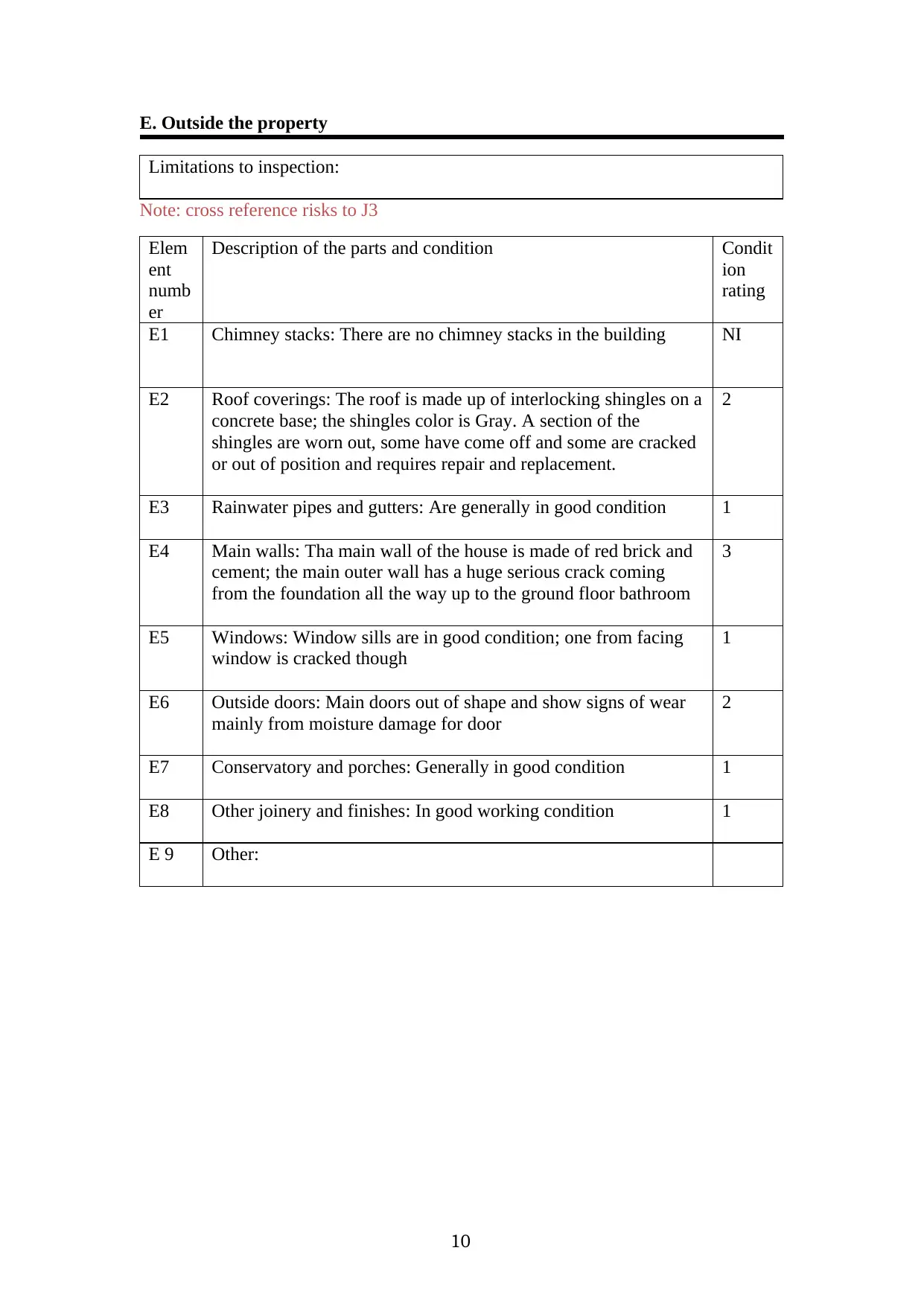
E. Outside the property
Limitations to inspection:
Note: cross reference risks to J3
Elem
ent
numb
er
Description of the parts and condition Condit
ion
rating
E1 Chimney stacks: There are no chimney stacks in the building NI
E2 Roof coverings: The roof is made up of interlocking shingles on a
concrete base; the shingles color is Gray. A section of the
shingles are worn out, some have come off and some are cracked
or out of position and requires repair and replacement.
2
E3 Rainwater pipes and gutters: Are generally in good condition 1
E4 Main walls: Tha main wall of the house is made of red brick and
cement; the main outer wall has a huge serious crack coming
from the foundation all the way up to the ground floor bathroom
3
E5 Windows: Window sills are in good condition; one from facing
window is cracked though
1
E6 Outside doors: Main doors out of shape and show signs of wear
mainly from moisture damage for door
2
E7 Conservatory and porches: Generally in good condition 1
E8 Other joinery and finishes: In good working condition 1
E 9 Other:
10
Limitations to inspection:
Note: cross reference risks to J3
Elem
ent
numb
er
Description of the parts and condition Condit
ion
rating
E1 Chimney stacks: There are no chimney stacks in the building NI
E2 Roof coverings: The roof is made up of interlocking shingles on a
concrete base; the shingles color is Gray. A section of the
shingles are worn out, some have come off and some are cracked
or out of position and requires repair and replacement.
2
E3 Rainwater pipes and gutters: Are generally in good condition 1
E4 Main walls: Tha main wall of the house is made of red brick and
cement; the main outer wall has a huge serious crack coming
from the foundation all the way up to the ground floor bathroom
3
E5 Windows: Window sills are in good condition; one from facing
window is cracked though
1
E6 Outside doors: Main doors out of shape and show signs of wear
mainly from moisture damage for door
2
E7 Conservatory and porches: Generally in good condition 1
E8 Other joinery and finishes: In good working condition 1
E 9 Other:
10
Paraphrase This Document
Need a fresh take? Get an instant paraphrase of this document with our AI Paraphraser
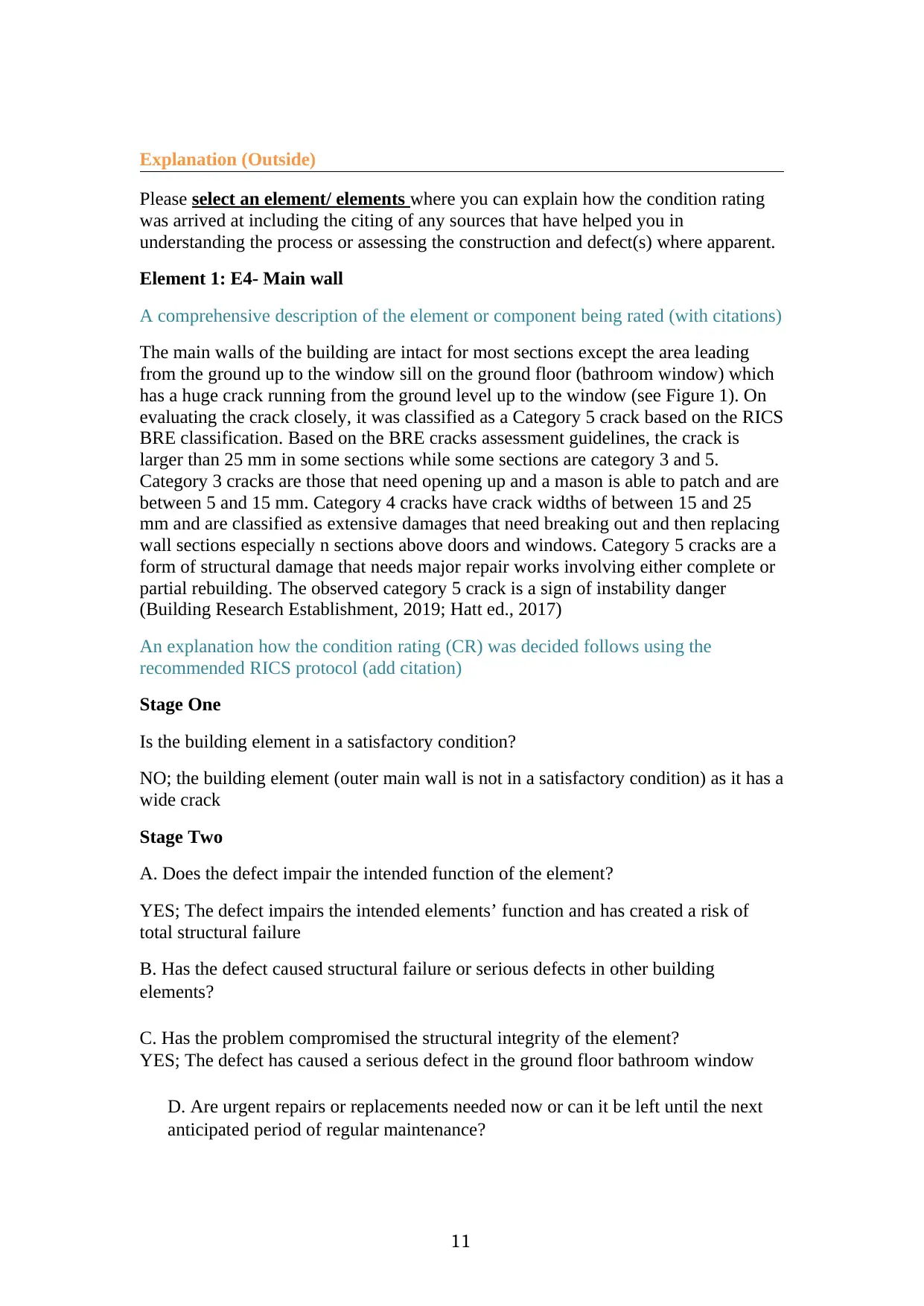
Explanation (Outside)
Please select an element/ elements where you can explain how the condition rating
was arrived at including the citing of any sources that have helped you in
understanding the process or assessing the construction and defect(s) where apparent.
Element 1: E4- Main wall
A comprehensive description of the element or component being rated (with citations)
The main walls of the building are intact for most sections except the area leading
from the ground up to the window sill on the ground floor (bathroom window) which
has a huge crack running from the ground level up to the window (see Figure 1). On
evaluating the crack closely, it was classified as a Category 5 crack based on the RICS
BRE classification. Based on the BRE cracks assessment guidelines, the crack is
larger than 25 mm in some sections while some sections are category 3 and 5.
Category 3 cracks are those that need opening up and a mason is able to patch and are
between 5 and 15 mm. Category 4 cracks have crack widths of between 15 and 25
mm and are classified as extensive damages that need breaking out and then replacing
wall sections especially n sections above doors and windows. Category 5 cracks are a
form of structural damage that needs major repair works involving either complete or
partial rebuilding. The observed category 5 crack is a sign of instability danger
(Building Research Establishment, 2019; Hatt ed., 2017)
An explanation how the condition rating (CR) was decided follows using the
recommended RICS protocol (add citation)
Stage One
Is the building element in a satisfactory condition?
NO; the building element (outer main wall is not in a satisfactory condition) as it has a
wide crack
Stage Two
A. Does the defect impair the intended function of the element?
YES; The defect impairs the intended elements’ function and has created a risk of
total structural failure
B. Has the defect caused structural failure or serious defects in other building
elements?
C. Has the problem compromised the structural integrity of the element?
YES; The defect has caused a serious defect in the ground floor bathroom window
D. Are urgent repairs or replacements needed now or can it be left until the next
anticipated period of regular maintenance?
11
Please select an element/ elements where you can explain how the condition rating
was arrived at including the citing of any sources that have helped you in
understanding the process or assessing the construction and defect(s) where apparent.
Element 1: E4- Main wall
A comprehensive description of the element or component being rated (with citations)
The main walls of the building are intact for most sections except the area leading
from the ground up to the window sill on the ground floor (bathroom window) which
has a huge crack running from the ground level up to the window (see Figure 1). On
evaluating the crack closely, it was classified as a Category 5 crack based on the RICS
BRE classification. Based on the BRE cracks assessment guidelines, the crack is
larger than 25 mm in some sections while some sections are category 3 and 5.
Category 3 cracks are those that need opening up and a mason is able to patch and are
between 5 and 15 mm. Category 4 cracks have crack widths of between 15 and 25
mm and are classified as extensive damages that need breaking out and then replacing
wall sections especially n sections above doors and windows. Category 5 cracks are a
form of structural damage that needs major repair works involving either complete or
partial rebuilding. The observed category 5 crack is a sign of instability danger
(Building Research Establishment, 2019; Hatt ed., 2017)
An explanation how the condition rating (CR) was decided follows using the
recommended RICS protocol (add citation)
Stage One
Is the building element in a satisfactory condition?
NO; the building element (outer main wall is not in a satisfactory condition) as it has a
wide crack
Stage Two
A. Does the defect impair the intended function of the element?
YES; The defect impairs the intended elements’ function and has created a risk of
total structural failure
B. Has the defect caused structural failure or serious defects in other building
elements?
C. Has the problem compromised the structural integrity of the element?
YES; The defect has caused a serious defect in the ground floor bathroom window
D. Are urgent repairs or replacements needed now or can it be left until the next
anticipated period of regular maintenance?
11
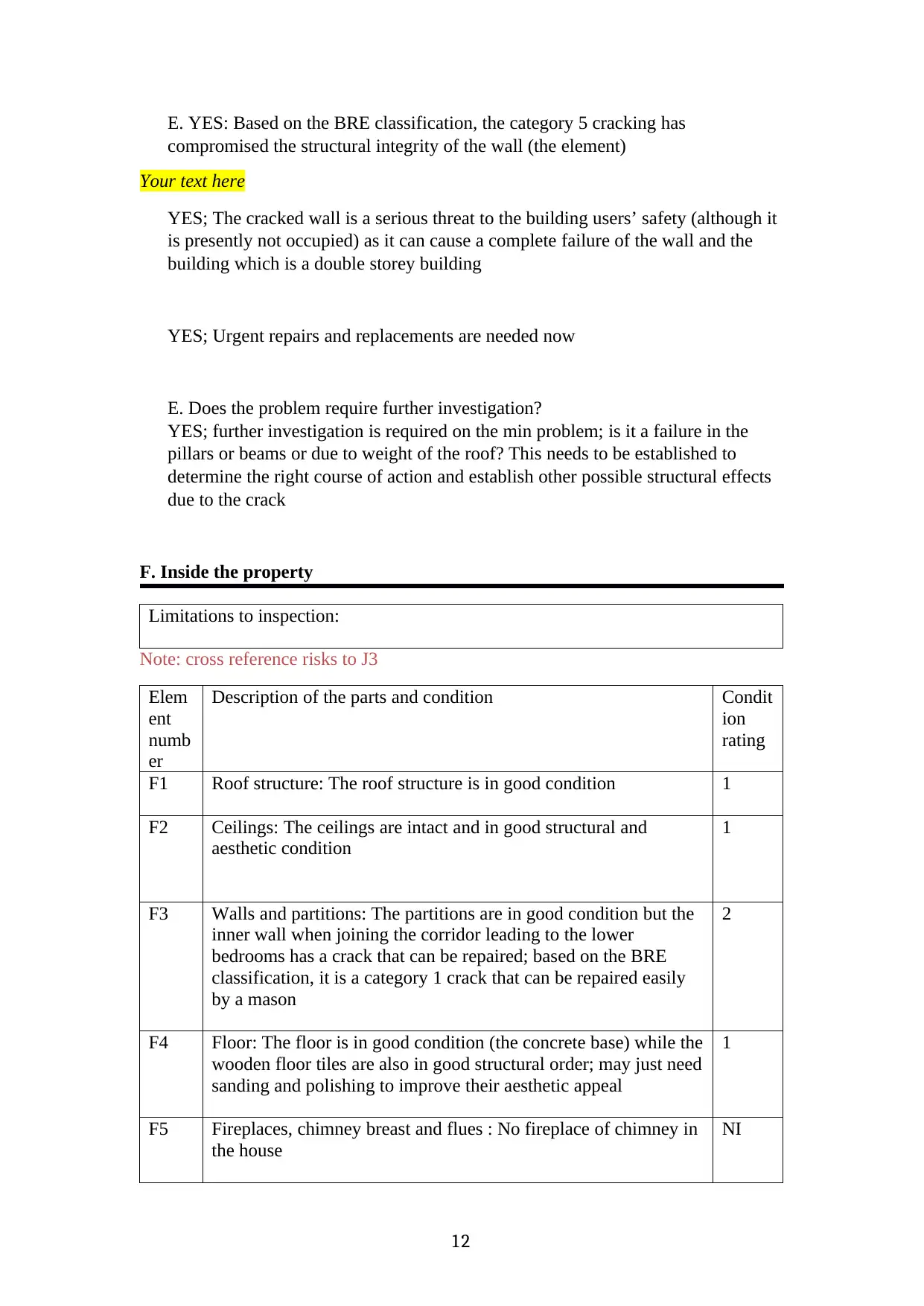
E. YES: Based on the BRE classification, the category 5 cracking has
compromised the structural integrity of the wall (the element)
Your text here
YES; The cracked wall is a serious threat to the building users’ safety (although it
is presently not occupied) as it can cause a complete failure of the wall and the
building which is a double storey building
YES; Urgent repairs and replacements are needed now
E. Does the problem require further investigation?
YES; further investigation is required on the min problem; is it a failure in the
pillars or beams or due to weight of the roof? This needs to be established to
determine the right course of action and establish other possible structural effects
due to the crack
F. Inside the property
Limitations to inspection:
Note: cross reference risks to J3
Elem
ent
numb
er
Description of the parts and condition Condit
ion
rating
F1 Roof structure: The roof structure is in good condition 1
F2 Ceilings: The ceilings are intact and in good structural and
aesthetic condition
1
F3 Walls and partitions: The partitions are in good condition but the
inner wall when joining the corridor leading to the lower
bedrooms has a crack that can be repaired; based on the BRE
classification, it is a category 1 crack that can be repaired easily
by a mason
2
F4 Floor: The floor is in good condition (the concrete base) while the
wooden floor tiles are also in good structural order; may just need
sanding and polishing to improve their aesthetic appeal
1
F5 Fireplaces, chimney breast and flues : No fireplace of chimney in
the house
NI
12
compromised the structural integrity of the wall (the element)
Your text here
YES; The cracked wall is a serious threat to the building users’ safety (although it
is presently not occupied) as it can cause a complete failure of the wall and the
building which is a double storey building
YES; Urgent repairs and replacements are needed now
E. Does the problem require further investigation?
YES; further investigation is required on the min problem; is it a failure in the
pillars or beams or due to weight of the roof? This needs to be established to
determine the right course of action and establish other possible structural effects
due to the crack
F. Inside the property
Limitations to inspection:
Note: cross reference risks to J3
Elem
ent
numb
er
Description of the parts and condition Condit
ion
rating
F1 Roof structure: The roof structure is in good condition 1
F2 Ceilings: The ceilings are intact and in good structural and
aesthetic condition
1
F3 Walls and partitions: The partitions are in good condition but the
inner wall when joining the corridor leading to the lower
bedrooms has a crack that can be repaired; based on the BRE
classification, it is a category 1 crack that can be repaired easily
by a mason
2
F4 Floor: The floor is in good condition (the concrete base) while the
wooden floor tiles are also in good structural order; may just need
sanding and polishing to improve their aesthetic appeal
1
F5 Fireplaces, chimney breast and flues : No fireplace of chimney in
the house
NI
12
⊘ This is a preview!⊘
Do you want full access?
Subscribe today to unlock all pages.

Trusted by 1+ million students worldwide
1 out of 22
Related Documents
Your All-in-One AI-Powered Toolkit for Academic Success.
+13062052269
info@desklib.com
Available 24*7 on WhatsApp / Email
![[object Object]](/_next/static/media/star-bottom.7253800d.svg)
Unlock your academic potential
Copyright © 2020–2025 A2Z Services. All Rights Reserved. Developed and managed by ZUCOL.



